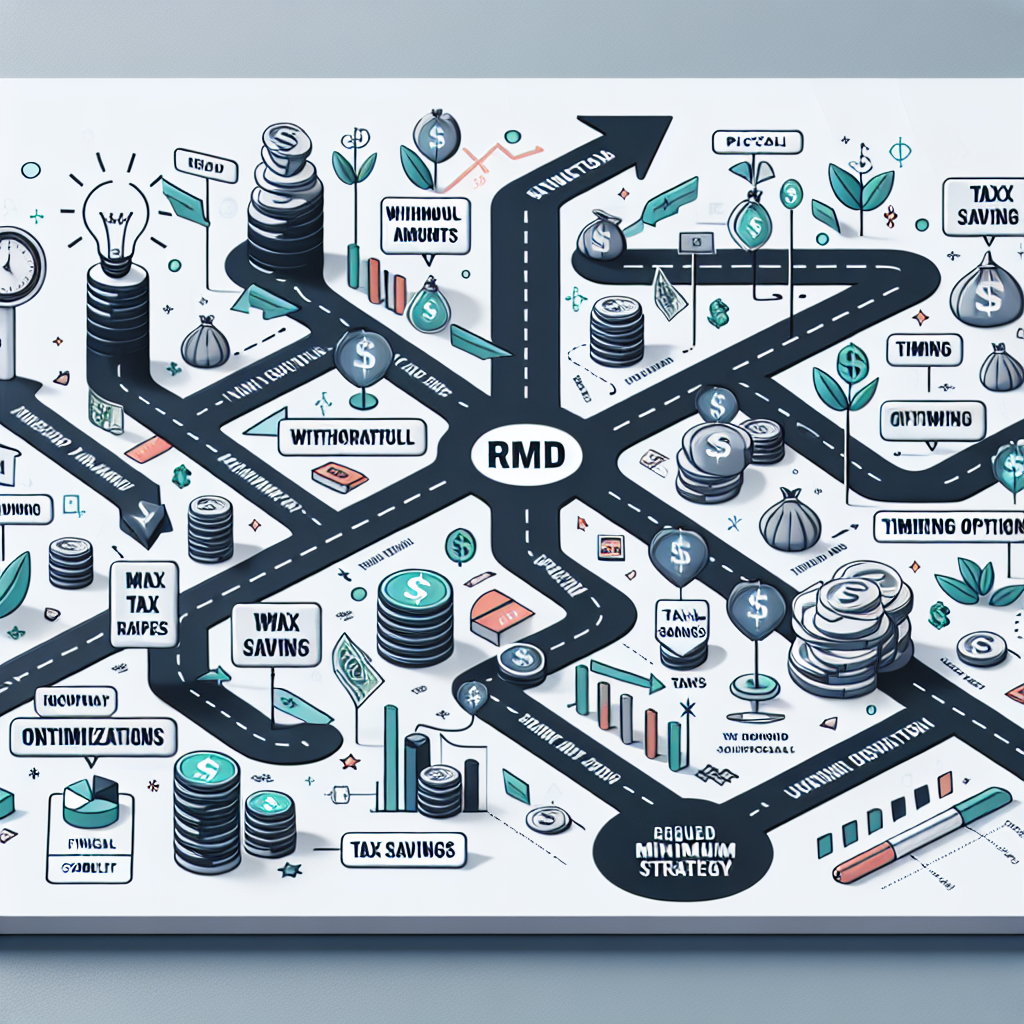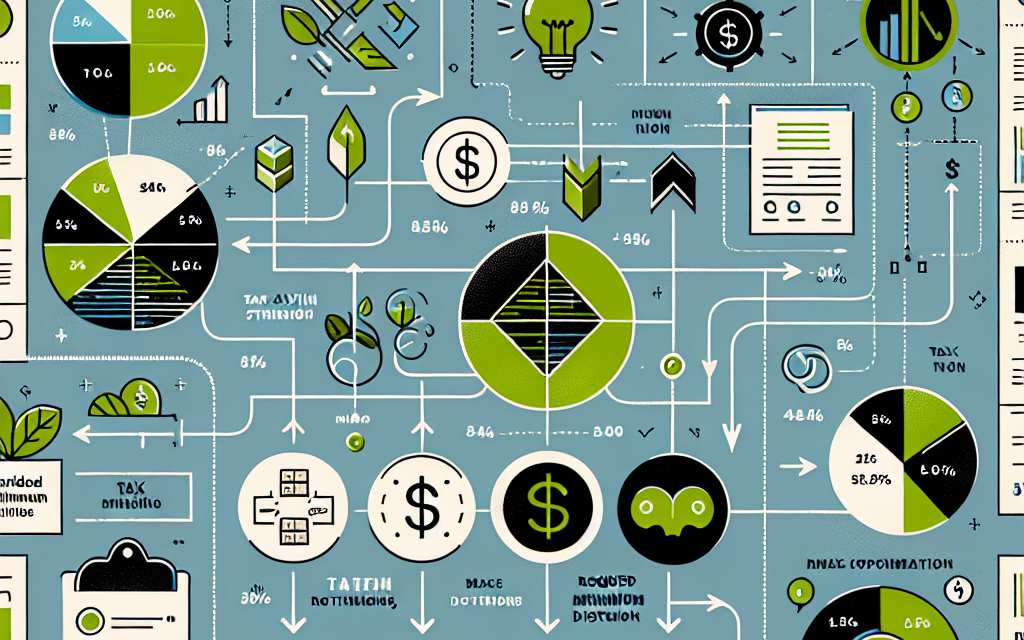“Unlock Smart Savings: Transform Your RMDs with Innovative Tax Strategies!”
Introduction
Discover an innovative tax-saving strategy for your Required Minimum Distributions (RMDs) that can help you optimize your retirement income and preserve more of your hard-earned savings. As retirees reach the age of 73, the IRS mandates annual withdrawals from traditional IRAs and 401(k) plans, which can significantly impact your tax liability. However, by employing strategic financial planning techniques, you can potentially reduce the tax burden associated with these distributions. This approach not only enhances your financial flexibility but also ensures that you can enjoy a more secure and comfortable retirement. Explore how this innovative strategy can transform your RMDs into a powerful tool for tax efficiency and long-term wealth preservation.
Understanding Required Minimum Distributions (RMDs) And Their Impact On Taxes
Required Minimum Distributions (RMDs) are a critical aspect of retirement planning that can significantly impact an individual’s tax situation. As individuals reach the age of 72, the Internal Revenue Service mandates that they begin withdrawing a minimum amount from their tax-deferred retirement accounts, such as traditional IRAs and 401(k)s. This requirement ensures that individuals do not defer taxes indefinitely, as these accounts were funded with pre-tax dollars. However, while RMDs are designed to ensure tax revenue, they can also lead to substantial tax liabilities for retirees, potentially pushing them into higher tax brackets and affecting their overall financial strategy.
Understanding the implications of RMDs is essential for effective tax planning. When retirees withdraw their RMDs, the amount is added to their taxable income for the year, which can have a cascading effect on their tax situation. For instance, the additional income from RMDs may increase the amount of Social Security benefits subject to taxation. Moreover, it can lead to higher Medicare premiums, as these are determined based on modified adjusted gross income. Consequently, retirees must carefully consider how RMDs fit into their broader financial picture to minimize adverse tax consequences.
One innovative strategy to mitigate the tax impact of RMDs involves the use of Qualified Charitable Distributions (QCDs). A QCD allows individuals aged 70½ or older to transfer up to $100,000 per year directly from their IRA to a qualified charity. This transfer counts toward satisfying the RMD requirement but is not included in the individual’s taxable income. By reducing taxable income, QCDs can help retirees avoid being pushed into higher tax brackets and reduce the taxation of Social Security benefits. Additionally, since QCDs are excluded from adjusted gross income, they can also help manage Medicare premiums.
Another approach to managing the tax implications of RMDs is through strategic Roth conversions. By converting a portion of traditional IRA funds to a Roth IRA before reaching the age of 72, individuals can potentially reduce the size of their future RMDs. Although the conversion itself is a taxable event, it can be strategically timed to occur in years when the individual is in a lower tax bracket. Once the funds are in a Roth IRA, they grow tax-free, and withdrawals are not subject to RMDs, providing greater flexibility in managing taxable income during retirement.
Furthermore, retirees can consider the timing of their RMDs to optimize their tax situation. While the first RMD must be taken by April 1 of the year following the year the individual turns 72, subsequent RMDs must be taken by December 31 each year. By carefully planning the timing of these withdrawals, retirees can potentially spread their tax liability over multiple years, thereby avoiding a large tax bill in any single year.
In conclusion, understanding the impact of RMDs on taxes is crucial for retirees seeking to preserve their wealth and maintain financial stability. By exploring innovative strategies such as Qualified Charitable Distributions, Roth conversions, and strategic timing of withdrawals, individuals can effectively manage their tax liabilities and enhance their overall retirement planning. As with any financial strategy, it is advisable to consult with a tax professional or financial advisor to tailor these approaches to individual circumstances and ensure compliance with current tax laws.
Innovative Tax-Saving Strategies For Managing RMDs
As individuals approach retirement, managing Required Minimum Distributions (RMDs) becomes a crucial aspect of financial planning. These mandatory withdrawals from retirement accounts, such as traditional IRAs and 401(k)s, can significantly impact one’s tax liability. However, there is an innovative tax-saving strategy that can help mitigate this burden: the Qualified Charitable Distribution (QCD). By understanding and utilizing QCDs, retirees can effectively manage their RMDs while supporting charitable causes.
To begin with, it is essential to comprehend the basic mechanics of RMDs. Once an individual reaches the age of 73, the IRS mandates annual withdrawals from their retirement accounts. The amount is determined by dividing the account balance by a life expectancy factor, which increases with age. These distributions are typically subject to ordinary income tax, potentially pushing retirees into higher tax brackets. Consequently, finding ways to reduce the taxable portion of RMDs is of paramount importance.
This is where the Qualified Charitable Distribution comes into play. A QCD allows individuals aged 70½ or older to directly transfer up to $100,000 per year from their IRA to a qualified charity. The key advantage of a QCD is that it counts toward satisfying the RMD requirement, yet it is excluded from taxable income. This dual benefit not only fulfills the RMD obligation but also reduces the overall tax liability, making it an attractive option for charitably inclined retirees.
Moreover, the benefits of QCDs extend beyond immediate tax savings. By lowering taxable income, retirees may also experience a reduction in the taxation of Social Security benefits and a decrease in Medicare premiums. These secondary effects can further enhance the financial well-being of retirees, providing a more comprehensive approach to tax-efficient retirement planning.
In addition to the financial advantages, QCDs offer retirees an opportunity to make a meaningful impact on the causes they care about. By directing their RMDs to charitable organizations, individuals can support initiatives that align with their values and contribute to the betterment of society. This philanthropic aspect adds a layer of personal fulfillment to the financial strategy, allowing retirees to leave a lasting legacy.
However, it is important to note that not all charitable contributions qualify as QCDs. To ensure compliance with IRS regulations, the distribution must be made directly from the IRA to the charity. Additionally, donor-advised funds and private foundations are not eligible recipients for QCDs. Therefore, careful planning and consultation with a financial advisor or tax professional are essential to maximize the benefits of this strategy.
Furthermore, while QCDs are a powerful tool for managing RMDs, they may not be suitable for everyone. Individuals with Roth IRAs, for instance, are not subject to RMDs, and thus, the QCD strategy would not apply. Additionally, those who rely on their RMDs for living expenses may need to weigh the benefits of tax savings against their cash flow needs.
In conclusion, the Qualified Charitable Distribution represents an innovative and effective tax-saving strategy for managing Required Minimum Distributions. By leveraging QCDs, retirees can reduce their taxable income, potentially lower other tax-related expenses, and support charitable causes that resonate with them. As with any financial strategy, it is crucial to seek professional guidance to ensure that this approach aligns with one’s overall retirement goals and financial situation.
How To Reduce Your Tax Burden With Smart RMD Planning
As individuals approach retirement, managing Required Minimum Distributions (RMDs) becomes a crucial aspect of financial planning. These mandatory withdrawals from retirement accounts, such as traditional IRAs and 401(k)s, can significantly impact one’s tax burden. However, with strategic planning, it is possible to mitigate the tax implications associated with RMDs. One innovative approach to consider is the Qualified Charitable Distribution (QCD), which offers a tax-efficient way to satisfy RMD requirements while supporting charitable causes.
To begin with, understanding the basics of RMDs is essential. Once an individual reaches the age of 73, the IRS mandates annual withdrawals from certain retirement accounts. The amount is calculated based on the account balance and life expectancy, and failure to comply can result in substantial penalties. These distributions are typically taxed as ordinary income, potentially pushing retirees into higher tax brackets. Consequently, finding ways to reduce the taxable portion of RMDs is a priority for many.
This is where the concept of Qualified Charitable Distributions comes into play. A QCD allows individuals aged 70½ or older to directly transfer up to $100,000 per year from their IRA to a qualified charity. The key advantage of a QCD is that it counts toward satisfying the RMD requirement but is not included in the taxpayer’s adjusted gross income (AGI). By lowering the AGI, retirees can potentially reduce their overall tax liability, as well as the impact on other tax-related factors such as Medicare premiums and Social Security taxation.
Moreover, utilizing QCDs can be particularly beneficial for those who do not itemize deductions. With the increase in the standard deduction following recent tax reforms, fewer taxpayers find it advantageous to itemize. However, a QCD provides a way to achieve a similar tax benefit without the need to itemize, as the distribution is excluded from taxable income altogether. This makes it an attractive option for retirees who are charitably inclined and wish to maximize their tax efficiency.
In addition to QCDs, another strategy to consider is the timing of RMDs. By carefully planning the timing of withdrawals, retirees can manage their taxable income more effectively. For instance, delaying the first RMD until the year following the year they turn 73 can result in a double distribution in that year, potentially increasing the tax burden. However, by taking the first RMD in the year they turn 73, individuals can spread the tax impact over two years, potentially keeping them in a lower tax bracket.
Furthermore, retirees should explore the possibility of converting a portion of their traditional IRA to a Roth IRA. While this strategy involves paying taxes on the converted amount, it can be advantageous in the long run. Roth IRAs do not have RMDs during the account holder’s lifetime, allowing the funds to grow tax-free. This can be particularly beneficial for those who anticipate being in a higher tax bracket in the future or who wish to leave a tax-efficient legacy to their heirs.
In conclusion, managing RMDs requires careful consideration and strategic planning to minimize tax liabilities. By leveraging innovative strategies such as Qualified Charitable Distributions and exploring options like Roth conversions, retirees can effectively reduce their tax burden while aligning their financial goals with their philanthropic aspirations. As with any financial decision, it is advisable to consult with a tax professional or financial advisor to tailor these strategies to individual circumstances and ensure compliance with IRS regulations.
Exploring The Benefits Of Qualified Charitable Distributions (QCDs)

As individuals approach the age of 73, they are required to begin taking Required Minimum Distributions (RMDs) from their traditional IRAs and other qualified retirement accounts. While these distributions provide a source of income, they also come with the burden of increased taxable income. However, there exists an innovative tax-saving strategy that can alleviate this burden: Qualified Charitable Distributions (QCDs). By understanding and utilizing QCDs, individuals can not only fulfill their philanthropic goals but also enjoy significant tax benefits.
To begin with, a Qualified Charitable Distribution allows individuals aged 70½ or older to directly transfer up to $100,000 per year from their IRA to a qualified charity. This transfer counts towards satisfying the RMD requirement, yet it is not included in the individual’s taxable income. This is particularly advantageous because it can help reduce the individual’s adjusted gross income (AGI), which in turn can lower the amount of Social Security benefits subject to tax and decrease Medicare premiums. Moreover, by keeping the AGI lower, individuals may also qualify for other tax credits and deductions that have income limits.
Furthermore, QCDs offer a unique advantage over traditional charitable contributions. Typically, when individuals make charitable donations, they must itemize their deductions to receive a tax benefit. However, with the increase in the standard deduction following the Tax Cuts and Jobs Act of 2017, fewer taxpayers find it beneficial to itemize. QCDs provide a way to gain a tax advantage from charitable giving without the need to itemize, as the distribution is excluded from taxable income altogether. This makes QCDs an attractive option for those who wish to support charitable causes while optimizing their tax situation.
In addition to the immediate tax benefits, QCDs can also play a strategic role in estate planning. By reducing the balance of an IRA through charitable distributions, individuals can potentially lower the tax burden on their heirs. This is because the funds transferred via QCDs are not subject to estate taxes, and the remaining IRA balance, which may eventually be inherited, is reduced. Consequently, QCDs can be an effective tool for those looking to manage their estate in a tax-efficient manner while supporting charitable organizations.
It is important to note that not all charitable organizations qualify for QCDs. The recipient must be a 501(c)(3) organization eligible to receive tax-deductible contributions. Additionally, donor-advised funds and private foundations are generally excluded from receiving QCDs. Therefore, individuals should ensure that their chosen charity meets the necessary criteria before proceeding with a QCD.
In conclusion, Qualified Charitable Distributions present a compelling opportunity for individuals to meet their RMD obligations while simultaneously achieving tax savings and supporting charitable causes. By directly transferring funds from an IRA to a qualified charity, individuals can reduce their taxable income, potentially lower their AGI, and avoid the need to itemize deductions. Moreover, QCDs can serve as a valuable component of an estate planning strategy, offering long-term benefits for both the donor and their heirs. As with any financial decision, it is advisable to consult with a tax professional or financial advisor to ensure that QCDs align with one’s overall financial goals and circumstances.
Leveraging Roth IRA Conversions To Minimize RMD Tax Liabilities
As individuals approach retirement, managing Required Minimum Distributions (RMDs) becomes a crucial aspect of financial planning. These mandatory withdrawals from traditional retirement accounts, such as IRAs and 401(k)s, can significantly impact one’s tax liabilities. However, an innovative strategy that has gained traction among financial advisors is leveraging Roth IRA conversions to minimize the tax burden associated with RMDs. This approach not only offers potential tax savings but also provides greater flexibility in retirement planning.
To understand the benefits of Roth IRA conversions in the context of RMDs, it is essential to first grasp the fundamental differences between traditional IRAs and Roth IRAs. Traditional IRAs allow individuals to make pre-tax contributions, which grow tax-deferred until withdrawals are made during retirement. Conversely, Roth IRAs are funded with after-tax dollars, and qualified withdrawals are tax-free. Notably, Roth IRAs do not require RMDs during the account holder’s lifetime, which presents a unique opportunity for strategic tax planning.
By converting a portion of a traditional IRA to a Roth IRA, retirees can effectively reduce the balance subject to future RMDs. This conversion involves paying taxes on the amount transferred, but the long-term benefits often outweigh the immediate tax cost. For instance, by strategically converting funds during years of lower income, retirees can potentially lower their overall tax rate. This is particularly advantageous for those who anticipate being in a higher tax bracket in the future or who wish to avoid the tax implications of large RMDs.
Moreover, Roth IRA conversions offer the added benefit of tax diversification. By having both traditional and Roth accounts, retirees can better manage their taxable income in retirement. This flexibility allows for more strategic withdrawals, enabling individuals to optimize their tax situation based on their unique financial circumstances. Additionally, Roth IRAs can serve as a valuable estate planning tool, as they can be passed on to heirs tax-free, providing a lasting legacy for future generations.
It is important to note that while Roth IRA conversions can be a powerful tool for minimizing RMD tax liabilities, they are not suitable for everyone. The decision to convert should be made after careful consideration of one’s current and projected financial situation. Factors such as current income, tax rates, and the potential impact on Social Security benefits should all be taken into account. Consulting with a financial advisor or tax professional can provide valuable insights and help determine the most appropriate strategy.
Furthermore, timing plays a critical role in the effectiveness of Roth IRA conversions. Ideally, conversions should be executed during years of lower taxable income to minimize the tax impact. This might include periods of reduced earnings, such as early retirement years before RMDs begin or years with significant deductions. By carefully planning the timing and amount of conversions, retirees can maximize the tax benefits and enhance their overall financial well-being.
In conclusion, leveraging Roth IRA conversions presents a compelling strategy for minimizing the tax liabilities associated with RMDs. By reducing the balance subject to mandatory withdrawals and providing greater flexibility in managing taxable income, this approach can significantly enhance retirement planning. However, it is essential to carefully evaluate individual circumstances and seek professional guidance to ensure that this strategy aligns with one’s long-term financial goals. As the landscape of retirement planning continues to evolve, innovative strategies like Roth IRA conversions offer valuable opportunities for optimizing tax efficiency and securing a more financially stable future.
The Role Of Annuities In RMD Tax Strategy
As individuals approach retirement, the management of Required Minimum Distributions (RMDs) becomes a crucial aspect of financial planning. These mandatory withdrawals from traditional IRAs and other qualified retirement accounts can significantly impact one’s tax liability. However, an innovative strategy involving annuities can offer a viable solution to mitigate the tax burden associated with RMDs. By understanding the role of annuities in RMD tax strategy, retirees can make informed decisions that align with their financial goals.
To begin with, it is essential to comprehend the nature of RMDs and their implications. Once an individual reaches the age of 73, the IRS mandates annual withdrawals from their retirement accounts, calculated based on the account balance and life expectancy. These distributions are subject to ordinary income tax, which can potentially push retirees into higher tax brackets, thereby increasing their overall tax liability. Consequently, finding effective strategies to manage these distributions is of paramount importance.
Annuities, particularly Qualified Longevity Annuity Contracts (QLACs), present a compelling option for those seeking to optimize their RMD tax strategy. A QLAC is a type of deferred income annuity that allows individuals to allocate a portion of their retirement savings, up to a specified limit, into an annuity contract. The primary advantage of a QLAC is that it permits the deferral of RMDs on the invested amount until the age of 85, thereby reducing the taxable income during the deferral period.
Moreover, incorporating annuities into an RMD strategy can provide retirees with a steady stream of income, which can be particularly beneficial for those concerned about outliving their savings. By deferring a portion of their RMDs through a QLAC, retirees can effectively manage their cash flow and ensure a more predictable income in the later stages of retirement. This approach not only addresses the immediate tax implications but also contributes to long-term financial security.
In addition to the tax deferral benefits, annuities offer a level of protection against market volatility. Unlike traditional investment vehicles, annuities provide guaranteed income, which can be particularly reassuring during periods of economic uncertainty. This stability can be a significant advantage for retirees who rely on their retirement savings to cover essential expenses. By incorporating annuities into their RMD strategy, individuals can achieve a balanced approach that combines tax efficiency with financial security.
Furthermore, it is important to consider the flexibility that annuities offer in terms of customization. Retirees can choose from a variety of annuity products, each with distinct features and benefits, to tailor their strategy according to their unique needs and preferences. Whether it is selecting a fixed or variable annuity, or opting for additional riders such as inflation protection, the ability to customize an annuity ensures that retirees can align their financial strategy with their long-term objectives.
In conclusion, the integration of annuities into an RMD tax strategy presents a multifaceted approach to managing retirement distributions. By leveraging the benefits of QLACs and other annuity products, retirees can effectively reduce their taxable income, secure a reliable income stream, and protect against market fluctuations. As with any financial decision, it is advisable to consult with a financial advisor to ensure that the chosen strategy aligns with one’s overall retirement plan. Through careful planning and consideration, retirees can navigate the complexities of RMDs and achieve a more tax-efficient and financially secure retirement.
Estate Planning Techniques To Optimize RMD Tax Savings
As individuals approach retirement, the management of Required Minimum Distributions (RMDs) becomes a crucial aspect of their financial planning. These mandatory withdrawals from retirement accounts, such as traditional IRAs and 401(k)s, can significantly impact one’s tax liability. However, with strategic estate planning, it is possible to optimize tax savings associated with RMDs, thereby preserving more wealth for future generations. One innovative strategy that has gained traction among financial advisors involves the use of Qualified Charitable Distributions (QCDs).
To understand the potential benefits of QCDs, it is essential to first grasp the basic mechanics of RMDs. Once an individual reaches the age of 73, the IRS requires them to begin taking annual distributions from their retirement accounts. The amount is determined based on the account balance and the individual’s life expectancy. These distributions are typically subject to ordinary income tax, which can be a substantial burden, especially for those in higher tax brackets. Consequently, finding ways to mitigate this tax impact is a priority for many retirees.
This is where QCDs come into play. A QCD allows individuals aged 70½ or older to directly transfer up to $100,000 per year from their IRA to a qualified charity. The transferred amount counts toward satisfying the RMD requirement but is excluded from taxable income. This dual benefit of fulfilling the RMD obligation while simultaneously reducing taxable income makes QCDs an attractive option for charitably inclined retirees.
Moreover, QCDs offer additional advantages beyond immediate tax savings. By lowering taxable income, retirees may also reduce their exposure to other tax-related costs, such as the Medicare surtax or the taxation of Social Security benefits. This cascading effect can lead to significant overall tax savings, enhancing the retiree’s financial position.
Furthermore, incorporating QCDs into an estate plan can align with broader philanthropic goals. Many retirees wish to leave a lasting legacy through charitable contributions, and QCDs provide a tax-efficient means to achieve this objective. By directing funds to causes they are passionate about, individuals can make a meaningful impact while simultaneously optimizing their tax situation.
However, it is important to note that QCDs are not suitable for everyone. For instance, those who rely on their RMDs for living expenses may not have the flexibility to divert funds to charity. Additionally, QCDs can only be made from IRAs, not from other types of retirement accounts like 401(k)s. Therefore, individuals should consult with a financial advisor to determine if this strategy aligns with their overall financial goals and circumstances.
In conclusion, as retirees navigate the complexities of RMDs, innovative strategies like QCDs offer a promising avenue for optimizing tax savings. By leveraging QCDs, individuals can fulfill their RMD obligations while simultaneously reducing their taxable income and supporting charitable causes. This approach not only enhances financial efficiency but also aligns with broader estate planning objectives, allowing retirees to leave a meaningful legacy. As with any financial strategy, careful consideration and professional guidance are essential to ensure that the chosen approach aligns with one’s unique financial situation and long-term goals.
Q&A
1. **What is an RMD?**
Required Minimum Distribution (RMD) is the minimum amount that a retirement plan account owner must withdraw annually starting at age 72 (or 73, depending on birth year) from their retirement accounts, such as IRAs and 401(k)s.
2. **Why is it important to manage RMDs?**
Managing RMDs is crucial because failing to withdraw the required amount can result in a hefty penalty, and the distributions are typically subject to income tax, impacting overall tax liability.
3. **What is a Qualified Charitable Distribution (QCD)?**
A QCD allows individuals aged 70½ or older to donate up to $100,000 directly from their IRA to a qualified charity, which can count towards their RMD and is excluded from taxable income.
4. **How can QCDs be a tax-saving strategy for RMDs?**
By using QCDs, individuals can satisfy their RMD requirements while reducing their taxable income, potentially lowering their overall tax burden and avoiding higher tax brackets.
5. **What are the eligibility requirements for making a QCD?**
The account holder must be at least 70½ years old, and the distribution must be made directly from the IRA to a qualified charity. The maximum annual QCD limit is $100,000 per individual.
6. **Can QCDs be made from any type of retirement account?**
No, QCDs can only be made from IRAs, including traditional, rollover, and inherited IRAs. They cannot be made from 401(k)s or other employer-sponsored retirement plans.
7. **What are the benefits of using QCDs over traditional charitable donations?**
QCDs reduce taxable income without requiring itemization, which can be beneficial for taxpayers who take the standard deduction. They also help manage RMDs and potentially reduce Medicare premiums and taxable Social Security benefits.
Conclusion
Discovering an innovative tax-saving strategy for your Required Minimum Distributions (RMDs) can significantly enhance your financial planning, especially in retirement. By effectively managing RMDs, you can minimize tax liabilities, potentially increase your retirement savings, and ensure a more stable financial future. Strategies such as Qualified Charitable Distributions (QCDs), Roth IRA conversions, or strategic withdrawals can be tailored to your specific financial situation, allowing you to optimize your tax outcomes. Consulting with a financial advisor or tax professional can provide personalized guidance, ensuring that you make informed decisions that align with your long-term financial goals.





